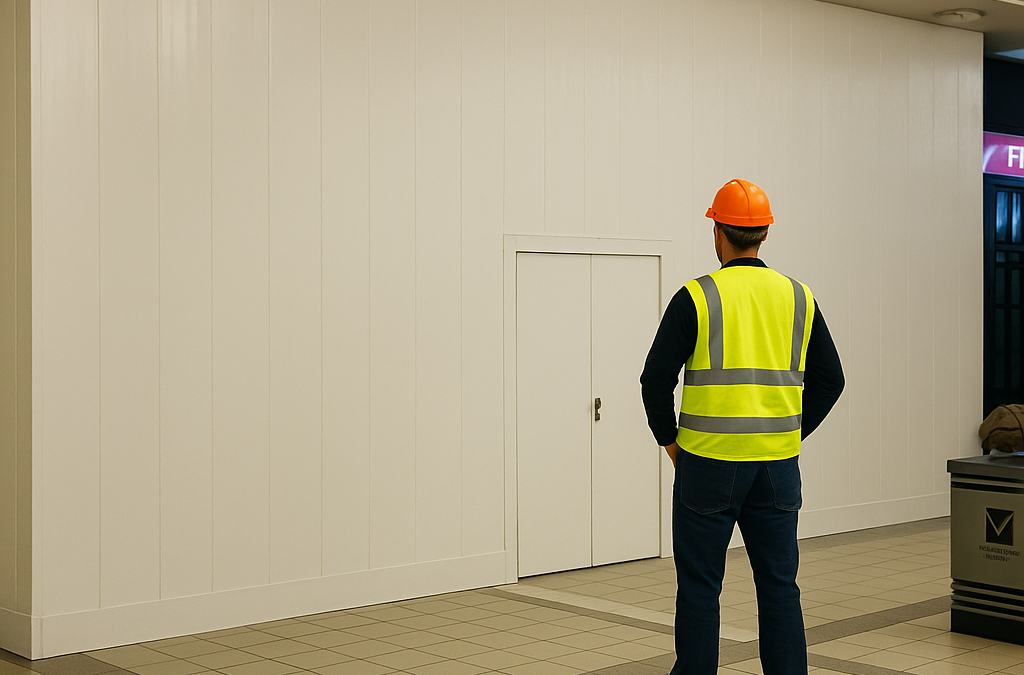In the ever-evolving landscape of retail and construction, ensuring the safety of personnel and property is paramount. Fire hoardings play a crucial role in this, acting as robust barriers designed to prevent the spread of flames during fit outs or refurbishments. As TECL partners with both independent retailers and major shopping center owners, our expertise in installing these fire-resistant partitions stands as a testament to our commitment to safety and compliance. Accredited by ISOCAD and third-party approved by FIRAS and BM Trada, we offer solutions that meet and exceed current building regulations, providing peace of mind to our clients. Join us as we delve into the essential aspects of fire safety management and explore how fire hoardings can be an integral part of a comprehensive fire safety strategy.
Understanding Fire Hoardings
Fire hoardings are essential components in retail and construction environments, providing critical protection against fire spread. Let’s explore their importance, types, and materials used.
Importance in Retail and Construction
Fire hoardings play a vital role in safeguarding both people and property during construction or renovation projects. They create a protective barrier that contains potential fires, limiting damage and ensuring safety.
In retail environments, these partitions allow businesses to continue operations while renovations occur nearby. They protect customers and staff from construction hazards and potential fire risks.
For construction sites, fire hoardings are crucial in preventing fire spread between different areas of the project. This compartmentalization is essential for maintaining overall site safety and complying with workplace fire safety responsibilities.
Types and Ratings of Fire Hoardings
Fire hoardings come in various types and ratings, each designed for specific applications and levels of fire resistance. The most common ratings are 30-minute and 60-minute fire resistance.
30-minute rated hoardings are suitable for many retail and light commercial applications. They provide a solid barrier against fire spread for half an hour, allowing ample time for evacuation and initial fire response.
60-minute rated hoardings offer enhanced protection, making them ideal for high-risk areas or where extended evacuation times may be necessary. These are often used in larger construction projects or areas with valuable assets.
Custom ratings can also be achieved for specialized applications, ensuring the right level of protection for every scenario.
Materials Used in Fire Hoardings
The effectiveness of fire hoardings largely depends on the materials used in their construction. Common materials include mineral fiber panels, steel-faced panels, and fire-resistant plasterboard.
Mineral fiber panels offer excellent fire resistance and thermal insulation. They’re lightweight yet durable, making them a popular choice for temporary installations.
Steel-faced panels provide robust protection and are often used in external applications. They offer weather resistance in addition to fire protection, making them versatile for various environments.
Fire-resistant plasterboard is another common material, especially for internal partitions. It’s easy to install and can be finished to match existing decor, making it ideal for retail environments.
Compliance and Safety Assurance
Ensuring compliance with safety regulations and providing peace of mind to clients are paramount in fire safety management. Let’s examine the key aspects of regulatory approvals, client assurance, and fire safety assessments.
Regulatory Approvals and Certifications
Regulatory approvals and certifications are crucial in the fire safety industry. They ensure that products and installations meet stringent safety standards and legal requirements.
TECL holds several important certifications, including ISOCAD approval and third-party approvals from FIRAS and BM Trada. These certifications demonstrate our commitment to quality and compliance.
Regulatory bodies regularly update standards to reflect new research and technologies. Staying current with these changes is essential for maintaining the highest levels of safety and legal compliance.
Ensuring Peace of Mind for Clients
Providing peace of mind to clients goes beyond mere regulatory compliance. It involves transparent communication, demonstrated expertise, and a track record of successful installations.
At TECL, we prioritize client communication throughout the installation process. We explain the specifics of our fire hoarding solutions, their ratings, and how they contribute to overall fire safety.
Our guarantee of compliance with current building regulations further reassures clients. This commitment to excellence and safety is what sets professional fire safety solution providers apart.
Fire Safety Assessment Essentials
A comprehensive fire safety assessment is crucial for identifying risks and implementing effective safety measures. This process involves several key steps and considerations.
- Identify potential fire hazards in the environment.
- Assess the risk to people in case of fire.
- Evaluate existing fire safety measures.
- Implement improvements where necessary.
- Create and maintain a fire management plan.
Understanding the three elements of the fire triangle – heat, fuel, and oxygen – is fundamental to fire safety management. By controlling these elements, we can prevent or mitigate fire risks.
At the heart of any fire safety management plan are the five elements of POCMAR:
- Planning
- Organizing
- Controlling
- Monitoring
- Auditing
- Reviewing
These elements ensure a comprehensive approach to fire safety, from initial assessment through to ongoing management and improvement.
“A thorough fire safety assessment is not just a legal requirement, it’s a moral obligation to protect lives and property,” says John Smith, Fire Safety Expert at HSE.
Remember, fire safety is an ongoing process. Regular assessments, staff training, and maintenance of fire safety equipment like fire extinguishers are all crucial components of a robust fire safety strategy.
